Preševo
Preševo (Serbian Cyrillic: Прешево; pronounced [prêʃeʋo]; Albanian: Preshevë) is a town and municipality located in the Pčinja District of southern Serbia. It is the southernmost town in Serbia (excluding Kosovo) and largest in the geographical region of Preševo Valley.
Preševo Прешево Preshevë | |
|---|---|
Town and municipality | |
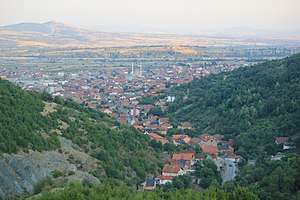 Panorama of Preševo | |
 Flag  Coat of arms | |
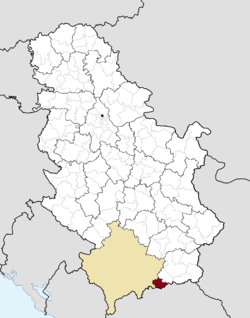 Location of the municipality of Preševo within Serbia | |
| Coordinates: 42°18′20″N 21°38′34″E | |
| Country | |
| Region | Southern and Eastern Serbia |
| District | Pčinja |
| Settlements | 35 |
| Government | |
| • Mayor | Shqiprim Arifi (APN) |
| Area | |
| • Town | 22.42 km2 (8.66 sq mi) |
| • Municipality | 264 km2 (102 sq mi) |
| Elevation | 463 m (1,519 ft) |
| Population (2002 census)[2] | |
| • Town | 13,426 |
| • Town density | 600/km2 (1,600/sq mi) |
| • Municipality | 34,904 |
| • Municipality density | 130/km2 (340/sq mi) |
| Time zone | UTC+1 (CET) |
| • Summer (DST) | UTC+2 (CEST) |
| Postal code | 17523 |
| Area code | +381(0)17 |
| Car plates | VR |
| Website | www |
Preševo is the cultural center of Albanians in Serbia. According to the 2002 census, the town of Preševo had a population of 13,426 people, while the municipality had 34,904 inhabitants. Albanians form the ethnic majority of the municipality, followed by Serbs, Roma and other ethnic groups.[3]
History
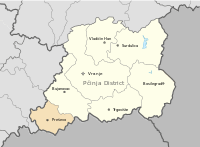
Slavs arrived roughly in the 7th century, when they first migrated to the Balkans, and by the Middle Ages, Preševo was part of the Kingdom of Serbia. According to Stefan Dušan's charter to the monastery of Arhiljevica dated August 1355, sevastokrator Dejan possessed a large province east of Skopska Crna Gora. It included the old župe (counties) of Žegligovo and Preševo (modern Kumanovo region with Sredorek, Kozjačija and the larger part of Pčinja).[4][5] As despot under the rule of Uroš V, Dejan was entrusted with the administration of the territory between South Morava, Pčinja, Skopska Crna Gora (hereditary lands) and in the east, the Upper Struma river with Velbuzhd, a province notably larger than during Dušan's life.[6][7][8] After the death of Dejan, his province, besides the župe of Žegligovo and Upper Struma, was appropriated to nobleman Vlatko Paskačić.[9] Dejan's eldest son Jovan also received the title of despot, like his father before, by Emperor Uroš.[10] In the new redistribution of feudal power, after 1371, the brothers despot Jovan and gospodin Konstantin greatly expanded their province.[11][12] Not only did they recreate their father's province but also at least doubled the territory, on all sides, but chiefly towards the south.[11] Ottoman sources report that in 1373, the Ottoman army compelled Jovan (who they called Saruyar) in the upper Struma, to recognize Ottoman vassalage.[13] As Prince Marko had done, also the Dejanović brothers recognized Ottoman sovereignty.[14] Although vassals, they had their own government.[12] In the Wallachian victory at the Battle of Rovine (17 May 1395), both Marko and Konstantin died.[15] The provinces of Marko and Konstantin became Ottoman.[15]
From 1877 to 1913 Preševo was part of Kosovo Vilayet of the Ottoman Empire. Following the First Balkan War in 1912, Kingdom of Serbia conquered the area.
Yugoslavia (1918–92)
Kingdom of Yugoslavia was formed after World War I. From 1929 to 1941 Preševo was part of the Vardar Banovina.
During the April War the Kingdom of Yugoslavia capitulated after 12 days of war against the Axis Powers. On April 20, Bulgaria occupied part of the Kingdom of Yugoslavia, including Preševo. The royal authoritarian dictatorship of Bulgaria occupied the area until September 7, 1944, when they handed the area over to Nazi Germany. The Albanian collaborationist regime along with Balli Kombëtar subsequently took over the area. In mid-November, the Partisans forced the Balli Kombëtar to retreat.[16]
From 1945 until 1992 Preševo was part of Socialist Republic of Serbia, within SFR Yugoslavia.
Breakup of Yugoslavia (1991–99)
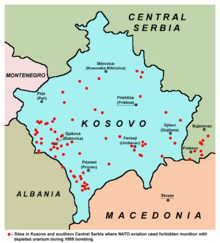
In 1992, the Albanians in the area organized a referendum in which they voted that Preševo, Medveđa and Bujanovac should join the self-declared assembly of the Republic of Kosova. However, no major events happened until the end of the 1990s.
During the NATO bombing of Yugoslavia in 1999, a total of 161 depleted uranium bullets have been recovered in Reljan near Preševo in southern Serbia. The Serbian government has funded the cleanup operation of the Reljan site with 350,000 euros.[17]
Following the breakup of Yugoslavia, and nearby Kosovo War which lasted until 1999, between 1999 and 2001, an ethnic Albanian paramilitary separatist organization, the UÇPMB, raised an armed insurgency in the Preševo Valley, in the region mostly inhabited by Albanians, with a goal to occupy these three municipalities from Serbia and join them to the self-proclaimed Republic of Kosova.
Following the overthrow of Slobodan Milošević, the new Serbian government suppressed the violence by 2001 and defeated the separatists. NATO troops also helped the Serbian government by ensuring that the rebels do not import the conflicts back into Kosovo.[18]
In 2009, Serbia opened a military base Cepotina 5 kilometers south of Bujanovac, to further stabilize the area.[19]
Modern
Today, Preševo is located in the Pčinja District of southern Serbia.
On 7 March 2017, the President of Albania Bujar Nishani made a visit to the municipalities of Bujanovac and Preševo, in which Albanians form the ethnic majority.[20]
Settlements
Aside from the town of Preševo, the municipality includes the following settlements:
Demographics
| Year | Pop. | ±% p.a. |
|---|---|---|
| 1948 | 23,379 | — |
| 1953 | 24,607 | +1.03% |
| 1961 | 26,738 | +1.04% |
| 1971 | 30,056 | +1.18% |
| 1981 | 33,948 | +1.23% |
| 1991 | 38,943 | +1.38% |
| 2002 | 34,904 | −0.99% |
| 2011[a] | 3,080 | −23.64% |
| Source: [21] | ||
According to the 2002 census results, the municipality of Preševo has 34,904 inhabitants. While the 2011 census was made, there was undercoverage of the census units owing to the boycott by most of the members of the Albanian ethnic community in the municipality of Preševo and neighboring municipality of Bujanovac.
Ethnic groups
According to the census conducted in 2002, Albanians form nearly 90% of the municipality, and over 95% of the town. Most of the remainder of its inhabitants are Serbs, who are mainly concentrated in the settlements of Ljanik, Svinjište, Slavujevac and Cakanovac. The rest of the settlements have an absolute Albanian majority.
The ethnic composition of the municipality:
| Ethnic group | Population 1961[22] |
Population 1971[23] |
Population 1981[24] |
Population 1991[25] |
Population 2002[26] |
Population 2011[27][a] |
|---|---|---|---|---|---|---|
| Albanians | 18,229 | 23,625 | 28,961 | 34,992 | 31,098 | 416 |
| Serbs | 6,741 | 5,777 | 4,204 | 3,206 | 2,984 | 2,294 |
| Romani | 146 | 312 | 434 | 505 | 322 | 271 |
| Macedonians | 43 | 71 | 36 | - | 21 | 14 |
| Muslims | 40 | 70 | 100 | 118 | 15 | 2 |
| Montenegrins | 14 | 8 | 19 | 7 | 2 | - |
| Yugoslavs | 94 | 18 | 27 | 35 | - | 1 |
| Others | 1,431 | 176 | 167 | 80 | 462 | 82 |
| Total | 26,738 | 30,057 | 33,948 | 38,943 | 34,904 | 3,080 |
Notable people
- Fidan Aliti, Albanian footballer, national team
- Arbnor Fejzullahu, Albanian footballer, national team
- Donika Nuhiu, Albanian singer
- Idriz Seferi, Albanian nationalist figure, born in Sefer
- Ilaz Zylfiu, Albanian-Serbian footballer
Economy
The following table gives a preview of total number of registered people employed in legal entities per their core activity (as of 2018):[28]
| Activity | Total |
|---|---|
| Agriculture, forestry and fishing | 11 |
| Mining and quarrying | 9 |
| Manufacturing | 660 |
| Electricity, gas, steam and air conditioning supply | 14 |
| Water supply; sewerage, waste management and remediation activities | 48 |
| Construction | 202 |
| Wholesale and retail trade, repair of motor vehicles and motorcycles | 529 |
| Transportation and storage | 343 |
| Accommodation and food services | 213 |
| Information and communication | 29 |
| Financial and insurance activities | 35 |
| Real estate activities | - |
| Professional, scientific and technical activities | 95 |
| Administrative and support service activities | 60 |
| Public administration and defense; compulsory social security | 628 |
| Education | 722 |
| Human health and social work activities | 295 |
| Arts, entertainment and recreation | 98 |
| Other service activities | 95 |
| Individual agricultural workers | 40 |
| Total | 4,127 |
Politics
Elections
In December 2005, the leader of the Albanian Democratic party (PDSH) Ragmi Mustafa became the president of the municipality. He was re-elected several times and served as the president of the municipality until 2016.
On 7 March 2017, the President of Albania Bujar Nishani made a historical visit to the municipalities of Preševo and Bujanovac, in which Albanians form the ethnic majority.[20] Three days later, Ardita Sinani became the president of the municipality of Preševo, following the resignation of Shqiprim Arifi due to the termination of the municipal coalition.[29]
Stele controversies 2012–13
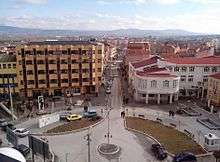
On 21 November 2012, the municipality council of Preševo erected a stele in the center of the town honouring members of the former UÇPMB, who died during the Preševo Valley Conflict from 1999 to 2001, causing a public outcry throughout Serbia. The Prime Minister of Serbia, Ivica Dačić, said about this incident: "It's best that they remove it themselves, because this is a needless provocation, nowhere else in Europe can a memorial plaque be erected to those who are members of terrorist organizations and those who were directly involved in the murders of police officers and soldiers".[30][31] He called for the removal of the stele to 17 January, then several Albanian politicians and organizations responded with criticism. Mayor of Preševo Ragmi Mustafa said that the stele shows the identity of the Albanians in the region and announced that it would end the cooperation with national authorities of Serbia if the monument were removed.[32] Serbian Minister of Defence Aleksandar Vučić announced that they will act in frame of the law in connection with the controversial stele, and that no one can act against the for all the same applicable constitution and seeks the reason in ethnicity. He added that Serbia wants peace but will respond to any provocation.[33]
Deputies of the Assembly of Kosovo Rexhep Selimi and Nait Hasani, a former member of the Kosovo Liberation Army (UÇK), threatened armed conflict if the institutions of Serbia removed the memorial plaque.[34] The former U.S. diplomat, United Nations regional representative of Kosovska Mitrovica Gerard Gallucci said: "Serbs, do not fall for provocations like this with the memorial plaque in Preševo".[35] President of the National Assembly of Serbia Nebojša Stefanović explained that it is unacceptable that in Serbia there is a memorial plaque to a terrorist organization and those who killed the citizens of Serbia.[36] He added that is not an ethnic conflict, but the problem is the honoring of those who killed Serbs with a memorial plaque in Serbia.[37] Nevertheless, a member of the Coalition of Albanians of the Preševo Valley, Jonuz Musliu, which has one seat in the Parliament of Serbia, said that the stele would not be removed.[38] However, the stele was removed by a bulldozer which was guarded by members of the Serbian Gendarmery on 20 January 2013. Despite threats from various Albanian nationalist organizations, there were no incidents during and after the removal.
As a first reaction, the former commander of UÇPMB, Orhan Rexhepi, made the separatist statement that this is a "historic day", because "Preševo and Bujanovac will be a part of Kosovo."[39] Ragmi Mustafa, Preševo's Mayor, confirmed shortly afterwards that the Albanians want a union with Kosovo for a long time.[40]
The former president of the National Council for Cooperation with the Hague Tribunal and a minister in Serbian government Rasim Ljajić responded and said that the Preševo valley will not be part of Kosovo or may be because the Albanian representatives from southern Serbia do not have the support of the international community. He also warned against the exploitation of the situation by the Albanians.[41] The operation of the Serbian police broke into the local population from turmoil. During the day, several hundred people gathered at the site of the stele laid flowers and candles in memory of the fallen UÇPMB members. The Albanian Prime Minister Sali Berisha announced that "the Albanian government calls the international institutions to stop this action", even though the U.S. had already announced earlier that it is an internal affair of Serbia, which should solve their elected representatives.[42]
On the evening of 20 January, a group of Albanians who protested against the removal of the stele gathered in Đakovica.[43] Some of them tried forcibly to enter in the Serbian monastery of the Holy Virgin, where several nuns still live, but the attack would prevented from strong associations of the KFOR.[43] On the night of 21 January, it overlapped to the Serbian enclave Goraždevac, were the monuments of the Serb victims of the NATO bombing in 1999, and the Serbian children who were shot at the Bistrica river by Albanians in 2003, desecrated and destroyed.[44][45] Thousands of Preševo citizens rallied on 21 January 2013, to protest the removal of the stele dedicated to Albanian guerrillas.[46] Serbian Prime Minister Ivica Dačić said that there was no reason for any kind of protests, the illicit stele was not destroyed, nor was violence used. He added that "not believe that in the United States, Al-Qaeda veterans, or those who have carried out several terrorist attacks in London or Paris, would decide whether a memorial stele should be built." The Albanian Prime Minister Sali Berisha announced during a press conference in Tirana, that Albania would review its relations with Serbia, if that is necessary. He also stated that the Albanian government will do everything in his power to help the Albanians in Serbia. Albin Kurti, leader of the Albanian radical organization Vetëvendosje said instead, that the most responsible for this situation is more likely in Kosovo, the government of Hashim Thaci.[47]
In response to the removal of the stele, dozens of Albanians, led by former UÇK veterans, destroyed a memorial plaque from the World War II in Vitina with a crane, and were not prevented by the Kosovo Police.[48] Till the evening of 21 January over 140 Serbian gravestones were destroyed throughout Kosovo,[49] burned a chapel and several crosses.[45] Subsequently, representatives of the United States, European Union, as well as the OSCE, KFOR and EULEX, sharply condemned the destruction of Serbian monuments and tombs.[45][49] They added that there is no justification for this violence, and that such actions were totally unacceptable.[45][49][50]
Culture
The Abdulla Krashnica Culture Center (Shtëpia e Kulturës "Abdulla Krashnica") is the home to various culture events in Preševo. Its complex includes the town library, music hall and theater. Preševo organizes the annual "Netët e komedisë" (The nights of comedy), a one–week festival with comedy shows from all the Albanian-speaking territories. The festival was first organized in 1994.
There are some natural heritage sites in Preševa Valley like: (Shpella e Ilincës), (Shpella e Arushës), (Trungu i Çarrit), (Burimi i ujit në Banjke), (Ujëndarësi i Preshevës). There has been some criticism, and Arsim Ejupi in his work Kërkime Gjeografike from 2013, claims that until now there were no activities regarding the protection and management of this natural heritage sites, and that this situation is a result of lack of capacities in local government and NGOs regarding the professional treatment of environmental issues. He considers that only with active participation of these actors it can be realized protection and sustainable management of natural heritage in Preševo Valley and the development of ecotourism in the region of Preševo Valley.[51]
See also
- List of places in Serbia
- Albanians in Serbia
References
- "Municipalities of Serbia, 2006". Statistical Office of Serbia. Retrieved 2010-11-28.
- "2011 Census of Population, Households and Dwellings in the Republic of Serbia: Comparative Overview of the Number of Population in 1948, 1953, 1961, 1971, 1981, 1991, 2002 and 2011, Data by settlements" (PDF). Statistical Office of Republic Of Serbia, Belgrade. 2014. ISBN 978-86-6161-109-4. Retrieved 2014-06-27.
- 2011 Census of Population, Households and Dwellings in the Republic of Serbia (PDF). Belgrade, Serbia: Statistical Office of the Republic of Serbia. 2011. pp. 3, 14. ISBN 978-86-6161-025-7.
- Историско друштво НР Србије 1951, pp. 20-21:
према повељи манастиру богоро- дичимог ваведења у Архиљевици,50 држао као своју баштину пространу област иеточно од Скопске Црне Горе. Она је обухватала старе жупе Прешево и Жеглигово (данас кумановски крај са Средореком, Козјачијом...
- Mandić 1986, p. 161:
У повељи манастиру Архиљевици, издатој ав- густа 1355. године, Душан на три места каже: "Брат царства ми севастократор Дејан". Именица брат има вишеструко значење. Најодређеније је оно примарно: рођени брат.
- Fajfric, 42
- Mihaljčić 1989, p. 81:
Дејанова баштина — жупе Жеглигово и Прешево — простиру се између Пчиње, Јужне Мораве и Скопске Црне горе. Источно од Жеглигова и Прешева, око горњег тока Струме са Велбуждом, простирала се "држава" севастократора Дејана
-
... старе жупе Жеглигово (са данашњом Козјачијом, Средореком и највећим делом Пчиње) на истоку и Прешево са једним делом Гњиланског Карадага на западу. Оно се није ограничавало само на кумановски крај — Жеглигово — ...
- Fajfric, 45. Braća Mrnjavčević
- Samardzic 1892 p. 22:
Синови деспота Дејана заједнички су управљали пространом облашћу у источној Македонији, мада је исправе чешће потписивао старији, Јован Драгаш. Као и његов отац, Јован Драгаш је носио знаке деспотског достојанства. Иако се као деспот помиње први пут 1373, сасвим је извесно да је Јован Драгаш ову титулу добио од цара Уроша. Високо достојанство убрајало се, како је ...
- Михаљчић 1975, p. 174
- Историјски гласник Друштва историчара СР Србије 1994, p. 31
- Edition de lA̕cadémie bulgare des sciences, 1986, "Balkan studies, Vol. 22", p. 38
- Ćorović 2001, ch. 3, XIII. Boj na Kosovu
- Ćorović 2001, ch. 4, I. Srbi između Turaka i Mađara
- Šta bi danas rekao Abdulah Krašnica
- Current Issues - Depleted Uranium Weapons in the Balkans
- Lobjakas, Ahto. "NATO: Yugoslav Officials Discuss Presevo Valley". rferl.org. Radio Free Europe / Liberty. Retrieved 22 April 2017.
- "Otvorena baza na jugu Srbije". b92.net (in Serbian). Beta. 23 November 2009. Retrieved 6 March 2017.
- "Musliu: Albanski predsednik Bujar Nišani posetiće 7. marta Bujanovac i Preševo". blic.rs (in Serbian). Beta. 3 March 2017. Retrieved 11 March 2017.
- "2011 Census of Population, Households and Dwellings in the Republic of Serbia" (PDF). stat.gov.rs. Statistical Office of the Republic of Serbia. Retrieved 11 January 2017.
- "Knjiga III: Nacionalni sastav stanovništva FNR Jugoslavije (1961)" (PDF). stat.gov.rs (in Serbian). Republički zavod za statistiku. Retrieved 3 March 2015.
- "Knjiga III: Nacionalni sastav stanovništva FNR Jugoslavije (1971)" (PDF). stat.gov.rs (in Serbian). Republički zavod za statistiku. Retrieved 3 March 2015.
- "Nacionalni sastav stanovništva SFR Jugoslavije (1981)" (PDF). stat.gov.rs. Republički zavod za statistiku. Retrieved 3 March 2015.
- "STANOVNIŠTVO PREMA NACIONALNOJ PRIPADNOSTI (1991)" (PDF). stat.gov.rs. Republički zavod za statistiku. Retrieved 3 March 2015.
- "Popis stanovnistva, domacinstava i stanova u 2002" (PDF). stat.gov.rs (in Serbian). Retrieved 3 March 2015.
- "Попис становништва, домаћинстава и станова 2011. у Републици Србији" (PDF). stat.gov.rs. Republički zavod za statistiku. Retrieved 3 March 2015.
- "MUNICIPALITIES AND REGIONS OF THE REPUBLIC OF SERBIA, 2019" (PDF). stat.gov.rs. Statistical Office of the Republic of Serbia. 25 December 2019. Retrieved 28 December 2019.
- "Ardita Sinani nova predsednica opštine Preševo". b92.net (in Serbian). Beta. 10 March 2017. Retrieved 11 March 2017.
- "PM: Government will react to provocation in Preševo". The B92. 21 November 2012. Archived from the original on 21 February 2013. Retrieved 8 January 2013.
- "Dačić: Ponašaćemo se evropski, uklonićemo spomenik u Preševu" (in Serbian). B92. 30 December 2012. Retrieved 8 January 2013.
- "Mustafa: Ako sklone spomenik nema saradnje sa Srbijom". Blic (in Serbian). 12 January 2013. Retrieved 16 January 2013.
- "Vučić najavio uklanjanje spomenika OVPMB u Preševu". The Blic (in Serbian). 13 January 2013. Retrieved 16 January 2013.
- "Poslanici skupštine Kosova: Mogući oružani sukobi zbog spomenika u Preševu". The B92 (in Serbian). 15 January 2013. Retrieved 16 January 2013.
- "Galuči: Srbi, ne nasedajte na provokacije u Preševu". Blic (in Serbian). 15 January 2013. Retrieved 16 January 2013.
- "Stefanović: Neprihvatljiv spomenik teroristima u Srbiji". The Blic (in Serbian). 16 January 2013. Retrieved 16 January 2013.
- "Stefanović: Neprihvatljiv spomenik teroristima u Srbiji". The Blic (in Serbian). 16 January 2013. Retrieved 16 January 2013.
- "Musliu: Spomenik u Preševu neće biti ni pomeren ni srušen, legalizovaćemo ga". The Blic (in Serbian). 15 January 2013. Retrieved 16 January 2013.
- "Gendarmes remove controversial monument". B92. 2013-01-20. Archived from the original on 2013-10-16. Retrieved 2013-01-20.
- "Ragmi Mustafa: Nije novina da želimo pripajanje Kosovu". Blic. 2013-01-20. Retrieved 2013-01-20.
- "Ljajić: Jug Srbije neće, niti može biti deo Kosova". Blic. 2013-01-20. Retrieved 2013-01-20.
- "Stav SAD nepromenjen: Spomenik u Preševu unutrašnja stvar Srbije". Blic. 2013-01-21. Retrieved 2013-01-22.
- "Demonstracije u Đakovici, pokušaj napada na manastir". Blic. 2013-01-21. Retrieved 2013-01-22.
- "Pomen ubijenoj deci u Goraždevcu". Blic. 2012-08-13. Retrieved 2013-01-21.
- "Oskrnavljena groblja i spomenik ubijenoj srpskoj deci u Goraždevcu". Blic. 2013-01-21. Retrieved 2013-01-22.
- "Serbia Albanians Protest Monument's Removal". Balkan Insight. 21 January 2013. Retrieved 21 January 2013.
- "Nekoliko hiljada Albanaca protestovalo u Preševu zbog uklanjanja spomenika". Blic. 2013-01-21. Retrieved 2013-01-22.
- "Pogledajte: Albanci bagerom srušili spomenik antifašističkoj borbi u Vitini, policija Kosova samo gledala". Blic. 2013-01-22. Retrieved 2013-01-22.
- "OEBS, Euleks i Kfor osuđuju skrnavljenja groblja". Blic. 2013-01-21.
- "OSCE condemns "repeated desecration of Orthodox graveyards"". B92. 2013-01-21. Archived from the original on 2014-02-03. Retrieved 2013-01-22.
- ^38 Arsim Ejupi| KËRKIME GJEOGRAFIKE Nr. 15, 2013 (39\49)|
Notes
| a. | ^ In the municipality of Preševo there was undercoverage of the census units owing to the boycott by most of the members of the Albanian ethnic community. |
